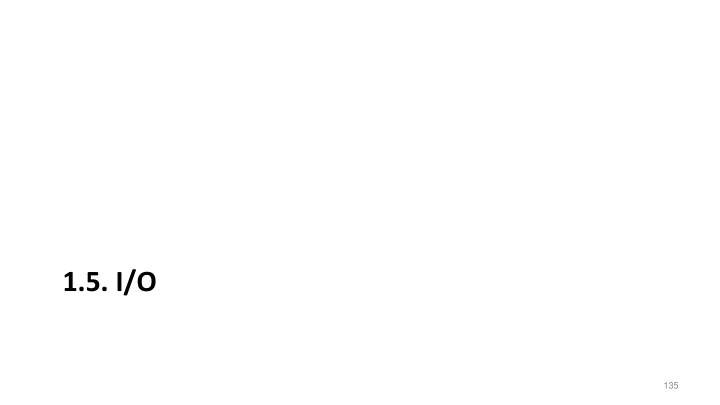

1.5. I/O 135
Serial Communication Simplex Duplex Half-Duplex 136
Serial Communication Master-Slave (Multi-)Master Multi-Slave Master Slave Master Master-Multi-Slave Slave Master Slave Slave Slave Slave 137
Serial Communication Synchronous Master Slave Asynchronous Master Slave 138
Some Bus Types Wires Directionality Synchrony Distance Speed typ. Remarks (+Gnd) typ. RS-232 2/4 – 7 full duplex asynchronous 10 m 115kbps / Point-to-Point +synchronous 1Mbps Interference prone RS-485 2/4 half/full duplex asynchronous 1000 m Mbps Differential Signalling SPI [aka SSP, 4 full duplex synchronous few cm 10 Mbps Master-Multi-Slave Microwire] with Slave select I 2 C 2 half duplex synchronous few m 100kbps- Addressed Multi-Master [SMBus] 3Mbps 1-Wire 1 half duplex time-slot tens of m 15kbps/ Master-Multi-Slave based, 125kbps Parasitic power synchronous USB 2.0 2 half-duplex asynchronous few m 12Mbits/ isochronous/ bulk/ + Vcc 480 MBits interrupt transfers USB 3.0 2/ full-duplex asynchronous few m 5/10 GBits 6 +DGnd + Vcc 139
SPI SCLK MOSI shift shift Master Slave MISO register register SS SS SCLK : Serial bit-rate Clock MOSI : Master data Output, Slave data Input shift Slave register MISO : Master data Input, Slave data Output SS : Slave Select 140
SPI Four wire serial bus invented / named by Motorola Serial connection between two or more devices (microprocessors, D/A converters) Configurations 1 Master, 1 Slave (single slave mode) 1 Master, N Slaves (multiple slave mode) Synchronous bidirectional data transfer Data transfer initiated by Master Bandwidth some KBits/s up to several MBits/s Simple implementation in software Used in a variety of devices, such as memory (flash, EEPROM), LCD displays and in all MMC / SD cards 141
Communication sampling SCLK SS MOSI Bit[7] Bit[6] Bit[5] Bit[1] Bit[0] End of transfer data state undefined Bit[7] Bit[6] Bit[5] Bit[1] Bit[0] undefined MISO MSB 8 bits LSB 142
Polarity Polarity = 0 SCLK Polarity = 1 Bit[7] Bit[6] Bit[5] Bit[1] Bit[0] End of transfer data state 143
Phase Phase = 0 SCLK Phase = 1 Bit[7] Bit[6] Bit[5] Bit[1] Bit[0] End of transfer data state 144
SPI – Data Transfer Master configures the clock Master selects slave (SS), followed by waiting period (if required by slave) Full duplex data transmission in each cycle Master sends bit over MOSI line, slave reads bit Slave sends bit over MISO line, master reads bit Two shift registers, one in slave, one in master for transfer When no data is to be transmitted any more, master stops toggling the clock No acknowledgement mechanism No device interrupts 145
Programming SPI 1. Bit-Banging Master GPIO Pins 146
Programming SPI 1. Bit-Banging FOR i := 7 TO 0 BY -1 DO IF ODD(ASH(data,-i)) THEN Platform.WriteBits(Platform.GPSET0, MOSI); ELSE Platform.WriteBits(Platform.GPCLR0, MOSI); END; Kernel.MicroWait(HalfClock); Platform.WriteBits(Platform.GPSET0, CLOCK); Kernel.MicroWait(HalfClock); Platform.WriteBits(Platform.GPCLR0, CLOCK); END; 147
Programming SPI 2. Using a Controller Master SPI Controller 148
Programming SPI 2. Using a Controller (* start transition *) Platform.SetBits(Platform.SPI_CS, {TA}); REPEAT UNTIL TXD IN Platform.ReadBits(Platform.SPI_CS); Platform.WriteWord(Platform.SPI_FIFO, data); junk := Platform.ReadWord(Platform.SPI_FIFO); REPEAT UNTIL DONE IN Platform.ReadBits(Platform.SPI_CS); (* transfer inactive *) Platform.ClearBits(Platform.SPI_CS, {TA}); 149
BCM 2835 Registers CLK CS -- Control and Status FIFO Register Clock Divider Chip Select Data FIFO Status Transfer Progress Other Interrupts Read: Write: DMA Control Polarity & Phase RX Fifo TX Fifo Special Mode Control 150
MAX7219 8-Digit LED Display Driver Max7219 Specification, p.5 151
MAX7219 8-Digit LED Display Driver Max7219 Specification, p.6 152
MMC and SD Cards Low cost memory system for persistent data on „solid state mass storage “ ( for example flash memory cards) Separate bus system 1 master, N slaves (cards) typically 1 master for one card Serial & synchronous transfer of commands and data Sequential read/ write Power Bus Block read/ write Supply Master Multi Media Card Bus Card Card Card (I/O) (ROM) (Flash) 153
MMC System Interaction Command and Clock for Response synchronous Channel transfer Host (BCM 2835) SD Card CLK CPU CMD Core EMMC SD Card Pins GPIO Pins DAT Controller SD Card Interface Controller Memory Bidirectional Data Channels 154
SD Card V DD CLK DAT0 DAT2 CMD DAT3 DAT1 OCR[31:0] CID[127:0] Power On Detection RCA[15:0] DSR[15:0] Card Interface Controller CSD[127:0] reset SCR[63:0] SSR[511:0] CSR[31:0] Memory Core Interface reset Memory Core SD Physical Layer Spec. P. 12 155
SD Mode vs SPI Mode Dat2Dat3CMD VDD GNDDat0 Dat1 CLK CS DI VDD CLK GND DO (Micro) SD Card Header SPI-MODE 156
Block Read/ Write Operation Read stop command from host to card from card to host data from card to host stops data transfer command response command response CMD data block crc data block crc data block crc DAT[0-7] block read operation data stop operation multiple block read Write data from host to card stop command from host to card from card to host stops data transfer busy from card to host command response command response CMD data block crc busy data block crc busy DAT[0-7] data stop operation block write operation multiple block write SD Physical Layer Spec. P. 6ff 157
RS232 Terminal [ DTE ] Data Set [ DCE ] (Modem) TxD UART RxD UART GND + RTS/RTR CTS if Hardware Flow Control 158
RS232 Signalling Sampling in the middle of bit intervals Time [+3v , +15 v] 0 v MSB LSB [-3v ,-15 v] (idle) (idle) 8 data bits start bit 1-2 stop bit(s) starts the local clock (+parity, if applicable) 159
UART Universal Asynchronous Receiver/ Transmitter Serial transmission of individual bits in byte packets (lowest significant bit first) Configurable source: Wikipedia Number of data bits per byte: 5, 6, 7, 8 Parity: odd, even, none Number of stop bits: 1, 1.5, 2 Transfer rate in bps (bits per second): 75, 110, 300,... , 115200 160
Implementation out in Port 2. Sender Send Line 1. Sender FIFO IRQ Trigger Sender buffer Application Hardware level Receiver buffer reached in IRQ Receiver FIFO 1. Receiver Receive Line 2. Port out UART Driver UART 161
Recommend
More recommend